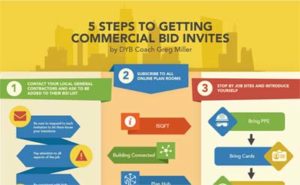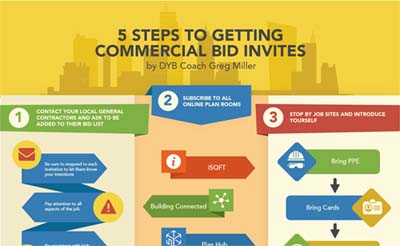
How to Pre-Qualify Your Prospects before Arriving to the Estimate
Hi there, I’m Greg from DYB Coach, also Green Pro Painting out of South Carolina.
5 Steps To Getting Commercial Bid Invites
Download the 5-Step Quick Reference Guide

We originally started off as a residential repaint company and kind of shifted gears to commercial.
Something that came up on our member’s thread last week that stood out to me, a conversation, a discussion, if you will, regarding qualifying jobs, and how to handle a particular client situation.
In this particular discussion, one of our members was faced with a question to not follow proper protocol with painting and in specifics, they had to repaint a ceiling and the customer wanted them to just caulk in the cram holding without painting it, anything below it as well.
If you are familiar with the painting process, everyone knows that you can’t leave exposed caulking without painting over it.
All the dirt, anything sticks to it, it stands out like a sore thumb over a very short period of time.
This particular member did not want to carry out the work specifically, and it got me thinking, this is a really important process for the business, is when you start to learn how to qualify your jobs.
What is “Pre-Qualifying” a Prospect?
When a customer calls your business, everyone that’s just getting started off gets really excited, and you really want to just charge ahead, look at every job, close the job, raise your numbers up and just grow the business.
But over time, what you realize is that you waste a lot of time on a particular project, kind of similar to this one.
Develop a Series of Questions
So, in the process of when someone calls in, you want to start to develop a series of questions that you ask, that hope you qualify your lead and determine whether or not it is something that you would want to move forward with.
There are keyword tracks that you can develop, that are kind of non-aggressive, non-insulting to the client because you don’t want to hurt someone’s feelings and make them feel as though you don’t want their work when you may possibly want it.
Ask Them What Items They Want To be Painted
One of the things that I like to ask is, when they say they want to have a living room painted, I ask them specifically, what items in the living room they want to have painted.
If they are on the phone, on the other end, they say, well, the ceilings looked good, and the trims are okay, so we are probably just going to paint the walls, we are going to change the color.
When Was the Home Last Painted?
So, then I followed up with this question when was the last time the home was painted?
Typically, the answer is, “we bought it.”
Okay, when was that? “1998.”
Everyone knows in here that being a contractor if a home has not been painted since 1998, everything needs to be done, the walls, the ceilings, the trim, everything needs to get caulked in.
This is an opportunity for you to explain your process and why you would go about that differently.
Make a Decision, But Keep Things Open-Ended
If the client decided to decline that specific process, then you can say, well thank you so much for calling, if you decide to change your mind and want to paint the rest of the substrates in that room, we will be happy to help you.
You kind of leave it open-ended and let them make the decision…
But it would save you from driving out there, from potentially a job where the people only want to spend $100 on the room.
If you want to accommodate that kind of work, that’s up to you.
For us, it didn’t work with our employees and instead of mobilizing for $100 job, it is just not worth our time.
There are people out there that do want to do this type of work, and if that’s you, that’s okay too, but you can still find out exactly what the client wants just from the initial phone number.
Thanks for dropping by guys. If you have any questions you can email me at greg@dybcoach.com – you can do this!

